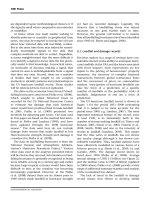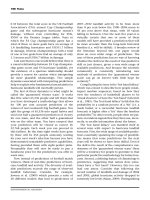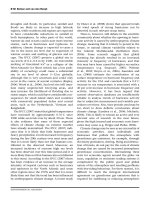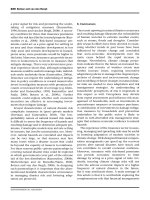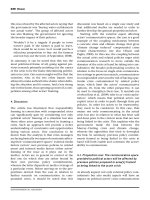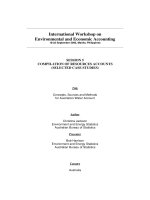Climate change as environmental and economic hazard - phần 1.1
Bạn đang xem bản rút gọn của tài liệu. Xem và tải ngay bản đầy đủ của tài liệu tại đây (576.27 KB, 8 trang )
ClimatechangeasenvironmentalandeconomichazardGuestEditor: Boris Porfiriev
Climate change as environmental
and economic hazard
Guest Editor
Boris Porfiriev
Russian Academy of Sciences
Climate change as environmental
and economic hazard
■ The current policy for climate change prioritizes mitigation over adaptation. The collected
papers of Climate Change as Environmental and Economic Hazard argue that although efforts
to reduce greenhouse gas emissions are still vital, the new policy paradigm should shift the
priority to adaptation, with a special focus on disaster risk reduction. It should also consider
climate change not purely as a hazard and a challenge, but rather as an opportunity to shift to
a new sustainable development policy model, a model designed to stress the particular
importance of communities’ resilience.
■ The papers in this special issue of the Environmental Hazards journal explore the key issues
linked to this shift, including:
●
Increasing research into the earth sciences, climate reconstruction and forecasting in
order to decrease the degree of uncertainty about the origin, development and
implications of climate change
●
The introduction of more binding and comprehensive regulation of both greenhouse gas
emissions and adaptation measures, like that in the United Kingdom
●
Matching climate policy with that for disasters and introducing it into mainstream
development strategies
This volume is a valuable addition to previous climate change research and considers a new
policy approach to this new global challenge.
■ Professor Boris Porfiriev is Director of the Risk and Crisis Research Center at the Institute
of Economics, Russian Academy of Sciences, Russia.
publishing for a sustainable future
9 781849 710893
ISBN 978-1-84971-089-3
www.earthscan.co.uk
Earthscan strives to minimize its impact on the environment
Economics/Environment
Environmental Hazards 8(3) September 2009.
Published by Earthscan: Dunstan House,
14a St Cross Street, London EC1N 8XA, UK.
# 2009 Earthscan
All rights reserved. No part of this publication may be
reproduced, stored in retrieval systems or transmitted in
any form or by any means, electronic, mechanical,
photocopying, recording or otherwise, without written
permission from the publisher.
ISSN: 1747-7891 (print), 1878-0059 (online)
ISBN: 978-1-84971-089-3
Responsibility for statements made in the articles printed
herein rests solely with the contributors. The views
expressed by individual authors are not necessarily those
of the editors or the publisher.
SUBSCRIPTIONS
Subscription prices for Volume 8:
Institutions
Online only: £247 $494 E323
Online & print: £260 $520 E340 (airmail extra)
Personal
Online only: £99 $199 E130
Print only: £99 $199 E130 (airmail extra)
Orders can be placed online at www.earthscan.co.uk/
journals/ehaz or sent to the journal’s distributors,
Portland Customer Services, using the contact details
below.
Post: Portland Customer Services, Commerce Way,
Colchester, CO2 8HP, UK
Fax: þ44 (0)1206 799331
Tel: þ44 (0)1206 796351
Email:
Abstracting services which cover this title include
Elsevier Scopus and GeoRef
Printed in the UK by MPG Books Ltd on FSC certified
paper.
Environmental Hazards is published quarterly. Periodicals
Postage Paid at Rahway, NJ. US agent: Mercury
International, 365 Blair Road, Avenel, NJ 07001.
POSTMASTER: Address changes to ENVIRONMENTAL
HAZARDS, 365 Blair Road, Avenel, NJ 07001.
www.earthscan.co.uk
GUEST EDITORIAL
167-170
Climate change: A hazard or an opportunity?
BORIS PORFIRIEV
RESEARCH
171-186
Strengthening socio-ecological resilience through disaster risk
reduction and climate change adaptation: Identifying gaps
in an uncertain world
WILLIAM M. COLLIER, KASEY R. JACOBS, ALARK SAXENA, JULIANNE
BAKER-GALLEGOS, MATTHEW CARROLL and GARY W. YOHE
187-200
United States hurricane landfalls and damages: Can one- to
five-year predictions beat climatology?
ROGER A. PIELKE JR
201-208
Building a low-carbon economy: The inaugural report of the
UK Committee on Climate Change
SAMUEL FANKHAUSER, DAVID KENNEDY and JIM SKEA
209-225
Managing natural disaster risks in a changing climate
W. J. W. BOTZEN and J. C. J. M. VAN DEN BERGH
226-240
Responsibility framing in a `climate change induced' compounded
crisis: Facing tragic choices in the Murray-Darling Basin
EVA-KARIN OLSSON
VOLUME 8 ISSUE 3 2009
SPECIAL ISSUE
Special issue: Climate change as environmental and economic hazard
Climate change: A hazard or an opportunity?
Boris Porfiriev*
Guest Editor, Risk and Crisis Research Center at the Institute of Economics, Russian Academy of Sciences,
Novocheriomushkinskaia, 42a, 117418 Moscow, Russia
Climate change is a serious environmental hazard that
affects communities and economies worldwide. Many of
the impacts of climate change are already in place with
even more in number and severity expected in the future,
seriously jeopardizing and compromising global econ-
omic development goals. Although the agents of the
impact are diverse and involve significant fluctuations in
the amount of precipitation, severity of the winds and
rising sea levels, to name a few, rising temperatures are
mentioned elsewhere in research literature and media as
a major driver (and effect) of climate change and of global
warming in particular.
Indeed, since the Industrial Revolution the mean sur-
face temperature of Earth has increased by an average
of 28C with most of this change occurring in the past
30–40 years, and the rate of increase appears to be accel-
erating. The leaders of the major G8 economies at the July
2009 Summit in Italy declared their recognition of the
broad scientific view that the increase in global average
temperature above pre-industrial levels ought not to
exceed 28C. It was also acknowledged that meeting
such a challenge requires a global response with all
countries sharing the ambitious goal of achieving at least
a 50 per cent reduction in total global ‘greenhouse gas’
CO
2
emissions by 2050, and recognizing the difference
in implementation capacity between developed and devel-
oping countries. The former are expected to reduce emis-
sions of greenhouse gases in aggregate by 80 per cent or
more by 2050 compared to 1990 (or more recent years).
Major emerging economies need to undertake quantifi-
able actions collectively to reduce emissions significantly
below business-as-usual by a specified year (Major Econ-
omies Forum, 2009).
However, such joint and spectacular declarations can-
not conceal two types of persisting discrepancy. One set
of doubts and disagreements exists within the research
community and concerns the major drivers of climate
change. The mainstream, headed by the IPCC with a
‘more than 90 per cent’ confidence range, maintains that
anthropogenic impact is key. Basing this crucial judgement
on the consensus between some 2,500 experts involved in
the IPCC process, the panel’s leaders are supported by
many top politicians including the UN General Secretary.
Some past and present leaders in the USA and Europe
imply such a consensus has been reached within the
whole research community. However, opponents do
exist. These opponents pinpoint the weaknesses of the
climate models used by the IPCC. They argue that much
evidence points to natural factors as a major driver of
climate fluctuations in the long-term retrospective
(measured in centuries rather than decades) and at least
as an important agent of recent change.
The point here is not to step on the shaky soil of disput-
ing who is more correct in physical terms – as I am not a
climatologist it is not worth even trying this – but rather to
emphasize the issue of degree of uncertainty which
is paramount in political and economic respects. Indeed,
following the mainstream interpretation of climate change,
assuming the human contribution to this change amounts
to as much as two-thirds of the total with the confidence
range of this assessment reaching 0.91,
1
would produce
an expectancy value of 60 per cent. However high and
salient from an ecological perspective, such a value
could hardly be perceived as a sufficient condition for
the decision to give priority to the unequivocal investment
of political and/or monetary capital in the reduction of
human impact on climate. At least, within the framework
of economic theory, mainstream or neoclassic economics
would regard this value as complying much more with
venture – or even speculation – rather than with ‘normal’
capital investment.
This adds to other predicaments of policy decision
making, including consideration of the major risks and
challenges to development and security other than climate
editorial
B *E-mail: b_porfi
ENVIRONMENTAL HAZARDS 8 (2009) 167–170
doi:10.3763/ehaz.2009.0026 # 2009 Earthscan ISSN: 1747-7891 (print), 1878-0059 (online) www.earthscanjournals.com
change, in particular those associated with the current
economic crisis. As a result, one more set of disputes
and controversies persists within business and political
communities concerning the most efficient policy strategy
for coping with climate change implications for the
environment, the economy and society as a whole.
These involve cleavages between both the advocates
and antagonists of ‘greening’ economic policy in specific
nations and between nations, in particular the countries
of Annex I and non-Annex I of the Kyoto Protocol. Within
the latter, disagreements between the USA, EU and
major emerging economies led by China proved to be
most important to the development of international climate
policy, including the success or failure of the forthcoming
summit in Copenhagen in December 2009.
Reducing the political, social and economic impli-
cations of climate change and the risks associated with
future climate policy requires concentration of efforts on
two interrelated policy areas or directions. The first
involves decreasing the degree of uncertainty about the
above-mentioned implications of climate change and
climate change itself. This calls for more investment of
human and pecuniary resources in Earth science
research – a unique source of data enrichment and knowl-
edge bases as well as better understanding of the yet
poorly or insufficiently recognized laws of nature that
drive climate change. In turn, this should facilitate develop-
ment of real scientific fundamentals of coping policy,
devoid of current ‘militaristic’ conceptualization as
revealed by the titles of international and national pro-
gramme documents full of ‘fight’, ‘combat’ and other
offensive and defensive operations ‘against’ climate
change (for example, see UNDP, 2007). Whatever the dis-
putes about the specific amount of natural variability input
into global climate change, none of the IPCC scholars –
let alone their opponents – doubt its conspicuous contri-
bution; throughout its history mankind has accumulated
too much experience of the consequences of ‘conquering’
or ‘struggling against’ nature. New research findings will
bring more evidence and substantiation of genuine effi-
cient climate policy which seriously considers and adapts
to – rather than fights against – nature.
The second policy area or direction focuses on what is
known as mainstreaming climate policy into the overall
development strategy. This initially implies the conceptual-
ization of the multiplicity and salience of major challenges
to development and security, all of which require political
and public awareness and economic resources for timely
and efficient policy treatment. In particular – and of no less
significance than climate change – natural and human-
made hazards should be considered and contrasted
against climate change and its implications. Such a com-
parison should involve weighing the full gamut of risks,
costs and benefits of handling these hazards using a multi-
criteria and systems approach towards the setting of
policy priorities and resource sharing.
In addition to and developing from these conceptual
issues, several implementation measures should be
employed. At the microeconomic level these range from
specific energy-saving and energy-efficient measures for
reducing carbon emissions to comprehensive risk man-
agement systems built into the corporate management
structures for handling all kinds of risks, from financial to
environmental. At the macroeconomic level these include
the state providing institutional support to businesses and
households to help them cut down emissions, and inte-
gration of both climate change and disaster risk reduction
policies into national and international development strat-
egies. This should include the incorporation of ‘green’
or ‘low-carbon’ economy development programmes into
national anti-hazard policy packages.
In relation to the latter, it is worth mentioning that 30
OECD member countries together with five candidates
for accession (Chile, Estonia, Israel, Russia and Slovenia)
and five Enhanced Engagement Partner countries (Brazil,
China, India, Indonesia and South Africa) will implement
the packages above worth more than US$2.3 trillion
between 2008 and 2010. These are the largest global fiscal
stimuli in history and at the same time could be considered
‘the greatest opportunity ever had for “greening” national
economies’ (Gurria, 2009). Already the governments
have allocated more than US$430 billion in fiscal stimulus
to key climate change investment issues alone, or almost
16 per cent of the total amount of these packages. China
and the USA, the major contributors to greenhouse gas
emissions, lead the way in absolute terms of resources
to be spent, while South Korea, the EU and France are
at the top of the list in terms of the percentage of the
total stimulus in relation to the sizes of the economies
(81, 59 and 21 per cent, respectively). Key sectoral bene-
ficiaries include rail transportation, water infrastructure,
grid expansion including ‘smart grid’ development and
improved building efficiency. Renewable energy has
received limited support in present packages, except in
the USA (Robins et al., 2009, pp. 2–3).
However, the most important aspect of the above com-
mitments is that one should perceive them as but the first
instalment of further efforts by governments to use
‘green’ growth as a master key lever for both economic
recovery (inclusive of G20 recovery talks) and to strengthen
the policy of reducing climate change hazards –
including the Copenhagen climate negotiations – instead
168 Porfiriev
ENVIRONMENTAL HAZARDS



